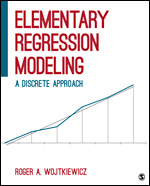Chapter 1: Introductory Ideas
Regression Modeling
Control Modeling
Modeling Interactions
Modeling Linearity With Splines
Testing Research Hypotheses
Classical Approach to Regression
Disadvantages of Classical Approach
Discrete Approach to Regression
Summary
Key Concepts
Notes
Chapter 2: Basic Statistical Procedures
Individual Units and Groups
Measurement
Level of Measurement
Examples for Level of Measurement
Count, Sum, and Transformations
Mean
Proportion and Percentage
Odds and Log odds
Examples of Means and Log Odds
Differences
Summary
Key Concepts
Chapter Exercises
Notes
Chapter 3: Regression Modeling Basics
Difference between Means: The t-test
Linear Regression With a Two-Category Independent Variable
Logistic Regression With a Two-Category Independent Variable
Linear Regression With a Four-Category Independent Variable
Logistic Regression With a Four-Category Independent Variable
Modeling Linear Effect With Dummy Variables
Linear Coefficient in Linear Regression
Linear Coefficient in Logistic Regression
Using Dummy Variables for a Continuous Variable
Summary
Key Concepts
Chapter Exercises
Notes
Chapter 4: Key Regression Modeling Concepts
Unit Vector: Estimating the Intercept
Nestedness
Higher-Order Differences
Constraints
Summary
Key Concepts
Chapter Exercises
Notes
Chapter 5: Control Modeling
Elementary Control Modeling
Elaboration for Controlling
Demographic Standardization for Controlling
Small and Big Models
Allocating Influence With Multiple Control Variables
One-at-a-Time Without Controls
Step Approach
One-at-a-Time With Controls
Hybrid Approach
Nestedness and Constraints
Example Using Logistic Regression
Summary
Key Concepts
Chapter Exercises
Notes
Chapter 6: Modeling Interactions
Interactions as Conditional Differences
Interactions Between Dummy Variables
Interactions Between Dummy Variables and an Interval Variable
Three-Way Interactions
Estimating Separate Models
Example Using Logistic Regression
Summary
Key Concepts
Chapter Exercises
Notes
Chapter 7: Modeling Linearity With Splines
Dummy Variables Nested in an Interval Variable
Introduction to Knotted Spline Variables
Spline Variables Nested in an Interval Variable
Regression Modeling Using Spline Variables
Working With a Continuous Independent Variable
Example Using Logistic Regression
Summary
Key Concepts
Chapter Exercises
Notes
Chapter 8: Conclusion: Testing Research Hypotheses
Bivariate Hypothesis/No Controls
Bivariate Hypothesis/Unanalyzed Controls
Bivariate Hypothesis/Analyzed Controls
Hypothesis Involving Interactions
Hypothesis Involving Nonlinearity
Final Comments
Key Concepts
Summary
Chapter exercises
Notes

 Sage College Publishing
Sage College Publishing





